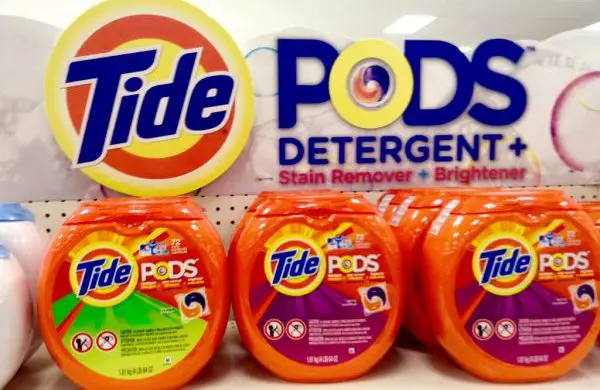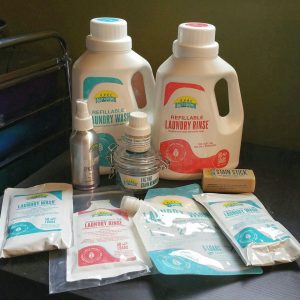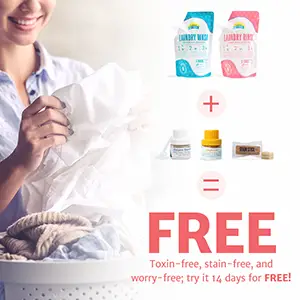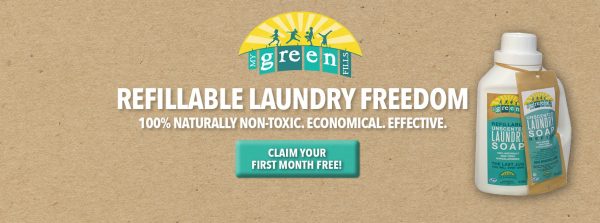
PHOTO: Flickr, Mike Mozart
Since the creation of laundry detergent in the 20th century, popular brands like Tide, Gain, and Arm & Hammer would like you to think that they have gotten safe to use for your family and the environment. But that’s completely false. Popular laundry detergents are as toxic as ever with no signs of wanting to change.
The Truth about the Tide Pod Challenge
Tide has clearly dominated the detergent market, and the company has gotten even more well-known after the dangerous “Tide Pod eating challenge” took over the Internet.
It is now impossible to talk about them without addressing this craze. What started as a joke when the Onion published a satire story about a child wanting to eat a laundry detergent pod, led to a YouTuber deciding to eat (or at least pretend to eat) a pod saying that it looked like candy. The video quickly went viral.
This led to a panic of health officials and parents who were worried that their children would do the challenge, and by doing so ingest a poisonous substance. In reality, the majority of this challenge is nothing but a joke to most teens. While poison control receives many phone calls every year about people accidentally eating laundry detergents pods, the number of phone calls last year was actually much lower than the previous year.
In 2016, they received 13,439 calls, and a 2017 – 12,299. Detergent pod poisoning numbers are actually lower, not higher after the challenge came out, so the panic may be completely unfounded.
There are, however, real reasons to be concerned with how toxic Tide and many other laundry detergents are. From carcinogenic contaminants and hazardous air pollutants to chemicals that release formaldehyde, Tide products contain ingredients that can lead to cancers, hormonal dysfunction, problems in the nervous system and liver damage.
Here are the worst of the worst ingredients to be aware of and avoid (and luckily, there is an increasingly popular non-toxic and environmentally-friendly alternative available).
Study: Toxic Chemicals Found in Laundry Products are Not Listed on The Label
Have you ever walked through the laundry aisle at a store and felt like you were going to pass out from all the fumes? There are real reasons why your body subconsciously wanted to get away from them as soon as possible: all of these fumes are toxic and lead to numerous health issues.
Scientists began raising red flags about this issue in 2008, but many consumers probably knew it before and after, suffering health reactions such as asthma and severe allergic skin issues.
When University of Washington researchers studied popular laundry products they found that every single one of them emitted toxic chemicals – the worst finding is that none of them were even listed on the ingredient label.
“I was surprised by both the number and the potential toxicity of the chemicals that were found,” said Anne Steinemann, a University of Washington professor of civil and environmental engineering and public affairs.
“Nearly 100 volatile organic compounds were emitted [in six products studied], and none were listed on any product label. Plus, five of the six products emitted one or more carcinogenic ‘hazardous air pollutants,’ which are considered by the Environmental Protection Agency to have no safe exposure level,” she said.
According to the researchers, manufacturers are not required to list ingredients used in laundry products that qualify as fragrances. The word “fragrance” is listed as an ingredient in most products, and that can mean any toxic chemical used to give the product a scent.
“Be careful if you buy products with fragrance, because you really don’t know what’s in them,” Steinemann added.
Including “fragrance,” there are some ingredients that you absolutely need to avoid in laundry products.
6 Toxic Chemicals in Detergent Brands You Should Never Allow in Your Home
1,4-dioxane
The chemical 1,4-dioxane is a petrochemical solvent used in paints, varnishes and cosmetics. It is also is a probable cancer contributor, and has been found in Tide and other popular detergents. When Women’s Voices for the Earth lab tested 20 cleaning products, they found “problematic levels” of 1,4-dioxane in Tide detergent (63 parts per million). Smaller amounts were fund in other products.
“We don’t fully understand how much 1,4 dioxane is needed to give someone cancer. For us, the bottom line is that Tide and Tide Free and Gentle are contaminated products,” Women’s Voices for the Earth stated.
Studies have shown that 1,4-dioxane is a human carcinogen, but it’s not the only thing we need to worry about. It was also linked to liver and kidney damage in laboratory animals, miscarriages and stillbirth risk, and is being passed to infants via breast milk from exposed mothers.
Besides detergent, it often contaminates shampoo, liquid soap, baby lotion, hair lotions, bath foam, and cosmetics.
This chemical, 1,4-dioxane is likely to contaminate many products that were created at the same sites that work with chlorinated solvents, especially TCA, according to the Environmental Protection Agency.
Which is unfortunately one of the reasons why even most natural detergents and organic products were found to be contaminated by this chemical (according to a report by Organic Consumers Association [OCA]).
While there is currently little hope for products like Tide, the OCA urges people to not give up on natural products, but find the ones that are truly natural:
“…Consumers should also take heart in the emergence of a growing number of companies…who are seeking to completely avoid petrochemicals in their cosmetic and personal care products.”
To make sure your detergent and other laundry products are completely safe and free of 1,4-dioxane, check out MyGreenFills, a new and fast-growing natural “green” cleaning products company from Michigan.
Sodium Lauryl Sulfate
Sodium Lauryl Sulfate (commonly known as SLS) is a synthetic soap that can be made from coconut oil or palm oil, but is most likely made out of petroleum waste product. Besides Tide detergent, it is also found in Colgate toothpaste. It is commonly know that it causes severe skin irritation.
What is less known is that it has been linked to endocrine disruption, and organ toxicity; and it is a neurotoxin. There is also a concern about it raising cancer risk because it bonds with formaldehyde. When it is not labeled under SLS, it can hide in the ingredients under sodium dodecyl sulfate, sulfuric acid, monododecyl ester, sodium salt, sodium salt sulfuric acid, sodium dodecyl sulfate, aquarex me or aquarex methyl.
SLS is another chemical that is contaminated by 1,4-dioxane, the carcinogenic chemical that is number 1 on this list. Make sure you are looking for a product that is SLS-free. Besides detergents, this pertains to toothpastes, shampoos, and personal care products.
DEA
DEA (Diethanolamine) is a common ingredient that raises your cancer risk. While there is a debate whether it is toxic by itself and if all sources of it are toxic, here is what we know. When DEA is made from higher quality new ingredients, it may not be so bad. But when it is made from cheap recycled chemicals (which happens often as the manufacturers are always trying to save money), that’s when it becomes hazardous. It is also inarguably damaging when used in combination with other toxins – and toxic laundry detergents have loads in them. When it is combined with other ingredients, it can form nitrosodiethanolamine (NDEA) – which can increase your link of fatal cancers.
Acetaldehyde
With this toxin, there is no debate – the EPA has classified it as a carcinogen with absolutely no safe exposure level. Yet, this chemical is emitted by scented laundry products. These emissions end up in vents and circulate toxins throughout your home – this is bad for your home health and environment.
“These products can affect not only personal health, but also public and environmental health. The chemicals can go into the air, down the drain and into water bodies,” Steinemann said.
“We focus a lot of attention on how to reduce emissions of pollutants from automobiles. And heres one source of pollutants that could be reduced,” she added.
This acetaldehyde chemical is likely to come from the “fragrance” in the ingredients. As stated earlier, manufacturers are not required to tell us what chemicals they are using as fragrance. Sadly, the nice smell from the laundry basket doesn’t have much to do with the cleanness of the clothes, and everything with the toxicity of the laundry products (unless you use natural products that use plant-based fragrances).
Phosphates
Phosphates are often added to detergents to prevent the dirt from sticking back to the newly washed clothes. Unfortunately, these chemicals are not good for the consumer or the environment (and there are much better options). Phosphates end up in streams and waterways and cause environmental damage and harm the ecosystems. Procter & Gamble, Tide manufacturer promised to remove phosphates from their products, but as with other companies it is usually substituted with EDTA, which is not better, and was confirmed to be toxic in animal studies.
Fragrance
Finally, fragrance is the last item on this list, but it has been associated with all the other five chemicals above. By definition, a fragrance is something that is used to make another object have a nice scent. In this case – it is detergent products. The problem with this is that the manufacturers can use any chemical as a fragrance and not have to disclose what they used. It can be toxic, it can be carcinogenic, it can be hazardous to the environment and our health, but the consumers won’t know until an outside party tests it and find hazardous quantities of concerning chemicals in it.
That is not to say that fragrance cannot be derived from natural sources such as plants and essential oils. However, the companies that are using natural ingredients will always disclose it. Whenever you see the word “fragrance” with no explanation of the source, it is most likely form an unknown and potentially toxic chemical source.
Non-Toxic Alternative: Completely Natural Laundry Products
If you are fed up with finding toxic ingredients in most laundry products, including the ones that claim to be “natural,” you are not alone.
Not being able to find the perfect clean products, one creative entrepreneur, Ruth Smith, started making her own to protect her children from chemicals that were causing them severe skin allergies. It all began with a homemade soap, but soon Ruth started making all kinds of hypoallergenic products at home. After 30 years of developing her lifelong passion, she was joined by an entrepreneur Stephen Ezell and together they decided to bring her non-toxic, safe, and effective products to her home. They started the company MyGreenFills together in order to provide a natural laundry alternative.
 Not only are their products free of all of the horrible chemicals we talked about above and many others, MyGreenFills also works to protect the environment through its subscription service. This is how it works. When joining MyGreenFills, you receive refillable laundry jug once. Then you refill them with ingredients that come in recyclable packaging. This helps to drastically cut back on dangerous plastic pollution.
Not only are their products free of all of the horrible chemicals we talked about above and many others, MyGreenFills also works to protect the environment through its subscription service. This is how it works. When joining MyGreenFills, you receive refillable laundry jug once. Then you refill them with ingredients that come in recyclable packaging. This helps to drastically cut back on dangerous plastic pollution.
Lastly, the company works with members of the Jamaica Deaf Village who make by hand Dryer Angels to keep your laundry fresh and static-free. They are healthier (and much cuter) than the dryer sheets, and are infused with essential oil. The proceeds from sales of these Angels help pay for education, housing and employment in the Jamaican deaf community.
MyGreenFills make many other laundry products as well: laundry wash and rinse, enzyme stain remover, chlorine-free bleach alternative, Dryer Angels, space fresheners, mineral sunscreen, and even non-toxic insect repellent. All of the products and non-toxic and better for the environment.
Out of 881 reviews, they have almost a perfect 5-star rating.
One review from Tay R. says:
“Knowing that my family is safe and healthy along with saving the environment by using MyGreenFills is such a relief. I am so thankful for finding them to keep my family healthy and keep the toxic chemicals out of our home. Make sure you detox your home by starting with your laundry room you will be glad that you did.”
Try MyGreenFills for yourself for free NOW, just pay a one-time shipping cost.
Watch MyGreenFills CEO explain just one reason why popular toxic detergents are hazardous for your health:
Recommended reading:
If You Use Any of THESE Household Cleaners, Throw Them Out Immediately!
Clothes: The Biggest Environmental Problem You’ve Never Heard Of. And It’s A HUGE Part Of Your Life
Thanks for installing the Bottom of every post plugin by Corey Salzano. Contact me if you need custom WordPress plugins or website design.






